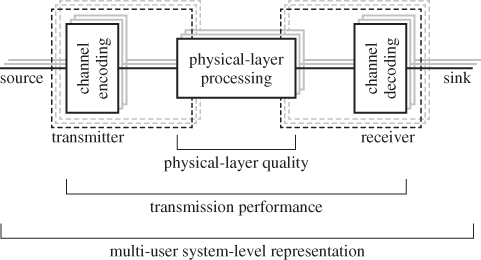Chapter 12
System-Level Modeling for MIMO-Enhanced HSDPA
12.1 Concept of System-Level Modeling
The problem in system-level modeling is to find a suitable mathematical abstraction of the physical layer. Generally speaking, such a model consists of two concatenated parts. Figure 12.1 shows a very abstract view of the transmission in a wireless communication system. Here, the whole transmission chain is divided into two parts. One part handles the physical layer processing, which includes in High-Speed Downlink Packet Access (HSDPA)
- spreading/despreading, scrambling/descrambling;
- modulation;
- precoding, space–time coding;
- channel estimation, synchronization; and
- receiver processing.
Figure 12.1 Abstract illustration of the transmission chain of a wireless communication system.

The second part handles the channel encoding and decoding. This part includes in HSDPA
- turbo coding/decoding;
- interleaving, rate-matching, Hybrid Automatic Repeat reQuest (HARQ); and
- demapping.
Note that both parts incorporate the transmitter and the receiver. When introducing such a split, the physical-layer processing can be modeled by a “link-measurement model,” which describes the physical-layer quality, and a “link-performance model,” describing the transmission performance with respect to the channel coding and decoding. For system-level purposes, the link-measurement model has to incorporate:
- the interference ...

